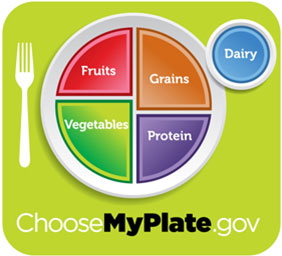Healthy Eating: Make Half Your Plate Fruits and Vegetables
Green Eats Fresh/Dried figs, with appetite appeal and healthy dose of nutrition, give you a head start on healthy eating and filling half your plate with fruits and vegetables. A tasty nutrition powerhouse, figs naturally have no fat of any kind, no cholesterol, no sodium. Our figs contain no added sugar and provide a source of much-needed nutrients—calcium, iron, potassium and fiber.
As you become familiar with the recommendations of the 2010 Dietary Guidelines for Americans, you will see how well figs fit into an active healthy lifestyle. Figs are great to take on hikes and keep handy as a nutrient-rich snack. Their delightfully crunchy tiny seeds add fiber that helps you feel full and satisfied longer. Available all year around, our Fresh/Dried Figs add a sweet, powerful nutrition punch to meals throughout the day.
Reach for figs when you’re looking for something quick, healthy and all natural. Enjoy the taste of good health with our Fresh/Dried Figs.
Eat Healthfully Using MyPlate as a Guide
MyPlate is part of a larger communications initiative based on 2010 Dietary Guidelines for Americans to help consumers make better food choices. MyPlate illustrates the five food groups using a familiar mealtime visual, a place setting.
Eating and physical activity patterns that are focused on consuming fewer calories, making informed food choices, and being physically active can help people attain and maintain a healthy weight, reduce their risk of chronic disease, and promote overall health. The Dietary Guidelines for Americans, 2010 exemplifies these strategies through recommendations that accommodate the food preferences, cultural traditions, and customs of the many and diverse groups who live in the United States.
Build a Healthy Plate
Before you eat, think about what goes on your plate or in your cup or bowl. Foods like fruits, vegetables, whole grains, low-fat dairy products, and lean protein foods contain the nutrients you need without too many calories. Try some of these options.
Make Half Your Plate Fruits and Vegetables
- Eat red, orange, and dark-green vegetables, such as tomatoes, sweet potatoes, and broccoli, in main and side dishes.
- Eat fruits, vegetables, or unsalted nuts as snacks—they are nature’s original fast foods.
Switch to Skim or 1% Milk
- They have the same amount of calcium and other essential nutrients as whole milk, but less fat and calories.
- Try calcium-fortified soy products as an alternative to dairy foods.
- Fig note: ounce-for-ounce figs contain about as much calcium as low fat milk and no fat or cholesterol.
Make at Least Half Your Grains Whole
- Choose 100% whole- grain cereals, breads, crackers, rice, and pasta.
- Check the ingredients list on food packages to find whole-grain foods.
Vary Your Protein Food Choices
- Twice a week, make seafood the protein on your plate.
- Eat beans, which are a natural source of fiber and protein.
- Keep meat and poultry portions small and lean.
Many people eat foods with too much solid fats, added sugars, and salt (sodium). Added sugars and fats load foods with extra calories you don’t need. Too much sodium may increase your blood pressure.
Choose Foods and Drinks with Little or No Added Sugars
- Drink water instead of sugary drinks. There are about 10 packets of sugar in a 12-ounce can of soda.
- Select fruit for dessert. Eat sugary desserts less often.
- Choose 100% fruit juice instead of fruit-flavored drinks.
- Fig note: figs are naturally sweet, no sugar is added to our whole figs.
Look Out For Salt (Sodium) In Foods You Buy—It All Adds Up
- Compare sodium in foods like soup, bread, and frozen meals—and choose the foods with lower numbers.
- Add spices or herbs to season food without adding salt.
Eat Fewer Foods That Are High In Solid Fats.
- Make major sources of saturated fats—such as cakes, cookies, ice cream, pizza, cheese, sausages, and hot dogs—occasional choices, not everyday foods.
- Select lean cuts of meats or poultry and fat-free or low-fat milk, yogurt, and cheese.
- Switch from solid fats to oils when preparing food.
Eat The Right Amount Of Calories For You
Enjoy your food, but eat less.
- Get your personal daily calorie limit at www.ChooseMyPlate.gov and keep that number in mind when deciding what to eat.
- Think before you eat...is it worth the calories?
- Avoid oversized portions.
- Use a smaller plate, bowl, and glass.
- Stop eating when you are satisfied, not full.
- Everyone has a personal calorie limit. Staying within yours can help you get to or maintain a healthy weight. People who are successful at managing their weight have found ways to keep track of how much they eat in a day, even if they don’t count every calorie.
- Fig note: a quarter cup (3 to 5) figs contains 110 calories. Because figs are full of fiber, you feel satisfied with just a few. Figs are nutrient rich, which means they give you lots of nutrients per calorie.
Cook More Often At Home, Where You Are In Control Of What’s In Your Food— When eating out, choose lower calorie menu options.
- Check posted calorie amounts.
- Choose dishes that include fruits, vegetables, and/or whole grains.
- Order a smaller portion or share when eating out.
- Fig note: when cooking at home, try some of our recipes. Figs also make a great healthy addition to salads, whole grain dishes, entrees and desserts. Look for ways to reduce sugars and use figs instead. You’ll be adding fiber and nutrients along with a naturally sweet taste.
- Write Down What You Eat To Keep Track Of How Much You Eat
Be Physically Active Your Way
Pick activities that you like and start by doing what you can, at least 10 minutes at a time. Every bit adds up, and the health benefits increase as you spend more time being active.
Use Food Labels To Help You Make Better Choices
- Most packaged foods have a Nutrition Facts label and an ingredients list. For a healthier you, use this tool to make smart food choices quickly and easily.
- Check for calories. Be sure to look at the serving size and how many servings you are actually consuming. If you double the servings you eat, you double the calories.
- Check for added sugars using the ingredients list. When a sugar is close to first on the ingredients list, the food is high in added sugars. Some names for added sugars include sucrose, glucose, high fructose corn syrup, corn syrup, maple syrup, and fructose.
- Fig note: our figs do not contain any added sugars. All the “sugar” in figs is naturally occurring.



